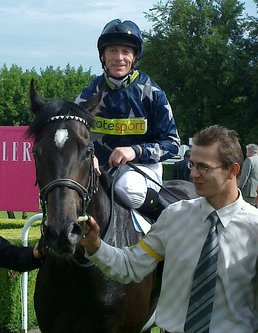Related Research Articles

The Derby Stakes, also known as the Derby or the Epsom Derby, is a Group 1 flat horse race in England open to three-year-old colts and fillies. It is run at Epsom Downs Racecourse in Surrey on the first Saturday of June each year, over a distance of one mile, four furlongs and 10 yards, or about 1½ miles. It was first run in 1780.

Horse racing is the second largest spectator sport in Great Britain, and one of the longest established, with a history dating back many centuries. According to a report by the British Horseracing Authority it generates £3.39 billion total direct and indirect expenditure in the British economy, of which £1.05 billion is from core racing industry expenditure, and the major horse racing events such as Royal Ascot and Cheltenham Festival are important dates in the British and international sporting and society calendar.

Kieren Francis Fallon is a retired Irish professional flat racing jockey and was British Champion Jockey six times.

The Oaks Stakes is a Group 1 flat horse race in Great Britain open to three-year-old fillies. It is run at Epsom Downs over a distance of 1 mile, 4 furlongs and 6 yards, about 1½ miles, and it is scheduled to take place each year in late May or early June. It is the second-oldest of the five Classic races, after the St Leger. Officially the Betfred Oaks, it is also popularly known as simply The Oaks. It has increasingly come to be referred to as the Epsom Oaks in both the UK and overseas countries, although 'Epsom' is not part of the official title of the race.)

Sea-Bird (1962–1973) was a French Thoroughbred racehorse and sire. In a career which lasted from 1964 until October 1965, he ran eight times and won seven races. Sea-Bird is most famous for his victories in two of Europe's most prestigious races, the Derby and the Prix de l'Arc de Triomphe. His Timeform rating of 145 remains the second highest flat figure behind Frankel's rating of 147 awarded by that publication.

Sir Percy is a British Thoroughbred race horse and sire. In a career which lasted from July 2005 to June 2007 he ran ten times and won five races. he was among the leading British two-year-olds of 2005, when his win included the Dewhurst Stakes. In the following year he recorded his most important success when winning The Derby. He was retired to stud after three unsuccessful starts in 2007.
Rock Sand (1900–1914) was a British Thoroughbred race horse and sire. In a career which lasted from the spring of 1902 until October 1904 he ran twenty times and won sixteen races. He was a leading British two-year-old of his generation, winning the 2,000 Guineas Stakes, The Derby, and the St. Leger Stakes. Therefore meaning he won the British Triple Crown. He won another series of major races as a four-year-old before being retired to stud, where he had success in both Europe and North America.

Epsom Downs is a Grade 1 racecourse in a hilly area near Epsom in Surrey, England which is used for thoroughbred horse racing. The "Downs" referred to in the name are part of the North Downs.

Authorized is an Irish-bred and British-trained Thoroughbred racehorse, winner of the 2007 Epsom Derby.

Reference Point was a British Thoroughbred race horse and sire. In a career which lasted from August 1986 to October 1987 he ran ten times and won seven races. As a three-year-old he overcame sinus problems before winning York's Dante Stakes, the Derby, Ascot's King George VI and Queen Elizabeth Diamond Stakes, the Great Voltigeur and St. Leger in 1987. It was not until 2012 that another Derby winner contested the St. Leger; when Camelot attempted, and failed, to win the English Triple Crown. His final race of the season resulted in failure in the Prix de l'Arc de Triomphe at Longchamp, Paris when an abscess was later found to have been responsible for his below-par performance.

Pour Moi is an Irish-bred and French-trained thoroughbred racehorse and sire. In his racing career, he ran five times between September 2010 and June 2011, and won three races, including the 2011 Epsom Derby. His career was ended by injury before he could run again and he was retired to stud.

Camelot is a British-bred, Irish-trained thoroughbred racehorse. He was one of the leading European two-year-olds of 2011 and won the Racing Post Trophy at Doncaster. On his three-year-old debut in 2012, Camelot won the 2000 Guineas at Newmarket and followed up by winning the Derby at Epsom and the Irish Derby at the Curragh. His bid for the Triple Crown failed narrowly when he finished runner-up in the St Leger.
Sixties Icon, is a retired British Thoroughbred racehorse and active sire. In a career which lasted from April 2006 until November 2008, he ran seventeen times and won eight races. He recorded his most important victory when winning the Classic St. Leger Stakes as a three-year-old. He won five other Group Races before being retired to stud.
Brian Boru is a retired Thoroughbred racehorse and active sire who was bred in Britain but was trained in Ireland. In a career which lasted from June 2002 until December 2004, he ran eighteen times and won four races. Brian Boru was made favourite for The Derby after winning the Racing Post Trophy in 2002. In September 2003 he recorded his most important win when winning the St Leger at Doncaster.

The City and Suburban Handicap is a flat handicap horse race in Great Britain open to horses aged four years or older. It is run over a distance of 1 mile 2 furlongs and 17 yards at Epsom in April during the Epsom Spring meeting. Inaugurated in 1851 it originally attracted top-class racehorses in the 19th and early 20th century; today its importance has been eclipsed by larger stakes races with more valuable purses.

The 2015 Epsom Derby was the 236th annual running of the Derby horse race and took place at Epsom Downs Racecourse on 6 June 2015. The race was won by the favourite, Golden Horn, a British-bred bay colt, owned by Anthony Oppenheimer, trained in Newmarket, Suffolk by John Gosden and ridden by Frankie Dettori. The colt's win was the first for his owner, the second for Dettori and the second for Gosden.
The 2016 Epsom Derby was the 237th annual running of the Derby horse race and took place at Epsom Downs Racecourse on 4 June 2016. The race was won by the Aga Khan's Harzand, ridden by Pat Smullen and trained in Ireland by Dermot Weld. Harzand's victory was the first in the race for his jockey and trainer, and the fifth for his owner, who had prior wins with Shergar, Shahrastani, Kahyasi and Sinndar.
Charles Marlow (1814–1882) was an English jockey of the mid 19th century period, known for his honesty and integrity. He is perhaps best remembered today for his association with Lord Eglington's horse The Flying Dutchman, on which he won the Derby, and St. Leger. He was badly injured during a race in 1855 and when he returned to the saddle he struggled to regain his form. His last years were spent in a workhouse and he died in an asylum.

Troutbeck (1903–1930) was a British Thoroughbred racehorse and sire. He was beaten in three starts as a juvenile in 1905 but improved to become an exceptional racehorse in the following year. He won his first three races in 1906 before sustaining his only defeat of the season when finishing third in the Epsom Derby. He won his next five races including the Jersey Stakes and the Sussex Stakes before ending the year with a win in the St Leger. He remained in training at four but failed to win any major races although he did finish second in the Coronation Cup. After his retirement from racing he stood as a breeding stallion in Britain and the United States but was not a success at stud.

Vedas was a British Thoroughbred racehorse. As a two-year-old in 1904 he was highly tried and won six of his ten races including the Brocklesby Stakes and Molecomb Stakes as well as being placed in the Coventry Stakes and Gimcrack Stakes. In the following spring he recorded his biggest win in the 2000 Guineas but was injured shortly afterwards and failed on his only subsequent start. He was reported to have died in early 1906.
References
- 1 2 3 Montgomery, Sue (9 August 2005). "Racing: New generation of Mitchell dynasty hits stride in style - More Sports, Sport". The Independent. London. Archived from the original on 23 December 2009. Retrieved 6 June 2010.
- 1 2 Ron Cox (15 August 2007). "Horse racing: Mitchell playing his cards right in strong year for young riders | Sport". The Guardian. London. Retrieved 6 June 2010.
- ↑ Lee, Alan (17 July 2008). "Philip Mitchell could be tempted back". London: Timesonline. Retrieved 6 June 2010.[ dead link ]
- ↑ "MITCHELL'S STAR ON THE RISE | Sporting Life - Horse Racing News | Live Racing Results, Racecards, Live Betting Shows". Sporting Life. 12 March 2010. Retrieved 6 June 2010.[ permanent dead link ]
- ↑ "Death of Cyril Mitchell aged 85 | Racing Post (London, England), The Newspaper | Find Articles at BNET". Findarticles.com. 31 January 2001. Retrieved 6 June 2010.[ dead link ]
- ↑ Graham Green (30 July 2009). "Jack Mitchell escapes injury after horror fall - Horse Racing News". Racing Post . Archived from the original on 26 October 2012. Retrieved 6 June 2010.
- ↑ Stuart Riley. "EPSOM Bertoliver holds off Hawkeyethenoo to win Dash - Horse Racing News". Racing Post . Archived from the original on 26 October 2012. Retrieved 6 June 2010.